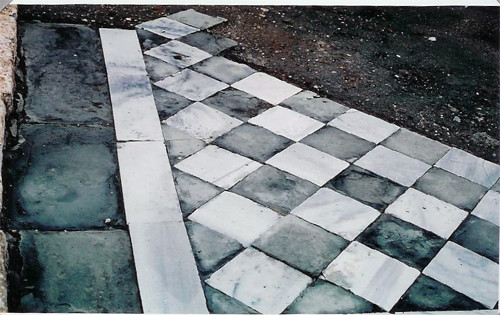Unlayering History
A series of fascinating archaeological digs are currently going on in Israel, each one of them, as it turns out, central to the religious history of Jews.For one, remains of 10th century monumental architecture have been located in the area of the city of David in Jerusalem. The archaeologist, Eilat Mazar, believes she may have uncovered a section of David's palace. Other archaeologists speculate that it may be a section of the Fortress of Zion, originally conquered by David from the Jebusites.
In either case, the find is important because so little archaeological evidence from that time exists, fueling speculation among some revisionist thinkers that the Bible's historical narrative is unreliable. And that David's kingdom was little more than that belonging to a typical tribal chieftain. If this find, indeed, shows some monumental architecture, that will alter the shape of the exchange for some time to come.
Among some Palestinians, such as Hani Nur el-Din, professor of archaeology at Al Quds University and his colleagues, the notion of historical revisionism takes on a more extreme form, as they claim that:
[B]iblical archaeology [is] an effort by Israelis "to fit historical evidence into a biblical context." [Professor Nur el-Din] added: "The link between the historical evidence and the biblical narration, written much later, is largely missing. There's a kind of fiction about the 10th century. They try to link whatever they find to the biblical narration. They have a button, and they want to make a suit out of it."In other words, like all good imperialists [thank you Edward Said for that unending plaint] biblical archaeologists are doing no more than forcing their narrative of history onto the scraps of data that are dug up in order to resurrect a foundation that, perhaps, was never there.
However, the Bible is one of the few historical records we have of this time. Moreover, it is a record that has impacted history to a considerable extent – that's an immovable fact. Obviously the notion of accurate history in the early biblical period differs entirely from our own. By our definition, the Bible is not attempting to preserve or represent the minutiae of accurate history. And indeed, in the larger philosophical sense, the accurate notion of history may not even be possible.
As historical knowledge is claimed to be privileged, I feel entitled (as I would not otherwise feel) to make the point that there is a twofold antinomy in the very notion of an historical fact. For, ex hypothesi, an historical fact is what really took place, but where did anything take place? Each episode in a revolution or a war resolves itself into a multitude of individual psychic movements. Each of these movements is the translation of unconscious development, and these resolve themselves into cerebral, hormonal or nervous phenomena, which themselves have reference to the physical or chemical order. Consequently, historical facts are no more given than any other. It is the historian, or the agent of history, who constitutes them by abstraction and as though under the threat of an infinite regress.Claude Lévi-Strauss -- The Savage Mind
Okay, those are the philosophical perimeters of the discussion.
 In reality, one of the finds uncovered so far is a seal, shown here, with the name of an official - Yehukal son of Shelemyahu son of Shevi - mentioned in in the Book of Jeremiah, which goes to show that by the late Seventh and Sixth century BCE, some of the minutiae detailed by the bible is borne out in physical remains.
In reality, one of the finds uncovered so far is a seal, shown here, with the name of an official - Yehukal son of Shelemyahu son of Shevi - mentioned in in the Book of Jeremiah, which goes to show that by the late Seventh and Sixth century BCE, some of the minutiae detailed by the bible is borne out in physical remains. [Edward Cook attempts to elucidate what we know of Yehukal son of Shelemyahu here. And one of his commenters, Robert Deutsch, suggests that the paleography on the inscription might point to an earlier date, late 8th, or the first half of the 7th century BC instead of late 7th or early 6th.]
Jim Davila thinks Professor Nur el-Din's criticism, above, is fair, though he, too, notes that he "look[s] forward to Professor Nur el-Din's condemnation of the Palestinian Authority's false claims that there never were Jewish Temples on the Temple Mount."
I, too, can't help reflect how self serving this kind of verbiage is at a time when the archaeological remains of the Second Temple – the actual, physical remains of the religious foundations of a people – are literally being disappeared into garbage heaps by a gleeful Waqf, the Muslim religious authority that controls the Temple Mount. No doubt, the Waqf, like Arafat, doesn't believe the historical artifacts they are destroying have any worth, since the Temple never existed. And true enough, if you get rid of the evidence, it is inescapable that soon there will be no evidence to prove the contrary position.
I remain clueless as to why neither the Sharon Government, nor the Israeli Antiquities Authority, are protesting this outrage more thoroughly. In fact, I suported Sharon for Prime Minister largely because I felt sure that his Government would weigh in more muscularly than Ehud Barak's to prevent the archaeological destruction of the Temple from continuing to take place. Which, in retrospect, appears colosally naive.
In Tiberias, ruins of a first century marble floor have been recovered.
Excavators believe these remains were part of the palace of Herod Antipas, the son of the founder of Tiberias, Herod the Great.That is, the Sanhedrin would have used this as its seat during the late second and third century, beginning decades after the Bar Kochba revolt. Discussions that appear in the Jerusalem Talmud may have taken place in this Sanhedrin originally.
The excavations focused on the city's basilica complex, believed to be the seat of the Sanhedrin – the ancient Jewish religious authority.
It's also nicely symbolic that a pefectly preserved water cistern has been found under the courtyard of the Sanhedrin, since traditionally there is an association of Torah with water.
And a street paved with basalt stones has also been recovered in Tiberias. This is of special interest to me, because I think the checked basalt and limestone street uncovered in Beit She'an is dramatic and beautiful.

Finally, we come to notice of the excavation of Tel Yavneh, the seat of the Sanhedrin immediately after the Destruction of the Second Temple, in the late first century and very early second century CE. Known as Jamnia during Roman Times. This is a dig still in its infancy, the last important, unexcavated Tel on the coastal plane of Israel. Which, um, tells you a whole lot, just by that fact, about the residual existent conflicts between the religious and the archaeologists.
Actually, last time I was in Israel, I assumed Yavneh would have been dug up already and tried to find it, despite the fact that it was nowhere to be seen on my map. Instead, after getting stuck in traffic at rush hour in downtown Yavneh, annoying in my first day in years in a car with stick shift – I ended up driving my rented car into some extremely restricted area on the coast, where the soldiers were not amused to find me looking for the Yavneh Archaeological Park. So I'm extremely glad that when I make my next trip, there will be a lot more to see.
UPDATE: The Anchoress points out the extremely weird anomaly of reading a post about the possible discovery of David's palace, only to be told that wealthy neo-conservative Jews funded and supported the dig.
What? Does the NYTimes writer think evil conservative funding will taint the dig? Make the archaeologist in charge less dependable because God forbid, she may be a conservative, too! And thus suspect! Or is this a scoop to show that the link between neo-conservatives and Zionists has finally been unearthed.
Evidently, the article, at least, wants to plant an inclination towards suspicion in the minds of its readers.
Or maybe the writer is just clueless is about how archaeological funding for digs is arranged.
Maybe the archaeologist in charge is just thrilled to get funding and doesn't inquire too closely whether the funder is liberal or conservative. Would this issue of funding been less sinister if a fabulously wealthy liberal had arranged it?







0 Comments:
Post a Comment
<< Home